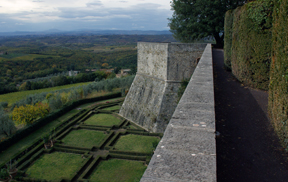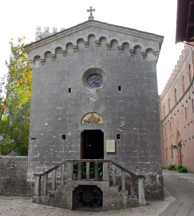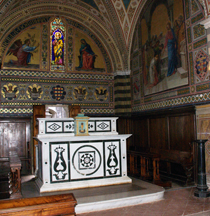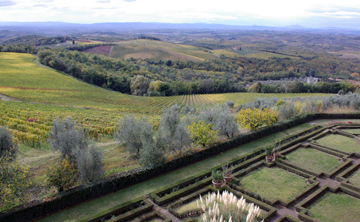Castello di Brolio
by
KL Sullivan
Summary: A visit to the castle that dominates the large Barone Ricasoli winery should be a part of your visit to the winery. A winding road from the winery tasting room traverses past cypresses and conifers, leading to the castle built in the 10th century. While visitors cannot enter the castle, they can enter the chapel and view elegant gardens below.
 If you wish to have a guided tour of the castle, arrange for a tour through the winery reception office. When you arrive you will meet your guide at the “Wine Shop.” Here we met our historical tour guide, Milena Mihaljevic Shortly thereafter, we were on our way up to the castle grounds. While we walked the grounds, our tour guide, Milena, described the importance of the castle and the grounds.
If you wish to have a guided tour of the castle, arrange for a tour through the winery reception office. When you arrive you will meet your guide at the “Wine Shop.” Here we met our historical tour guide, Milena Mihaljevic Shortly thereafter, we were on our way up to the castle grounds. While we walked the grounds, our tour guide, Milena, described the importance of the castle and the grounds.
The castle was a fortified village in the 10th century. The monks of Badia Fiorentina owned the castle built about 1000 A.D. By 1142 A.D., the Ricasoli Barons owned the property. The castle has been owned by the Ricasoli family ever since.
Until the unification of Italy in 1861, the castle was the site of many sieges fought between Florence and Siena. For hundreds of years Brolio Castle sided with Florence allied with the Papacy. Siena was allied with the Empire based in Germany. In 1478, the Sienese with the help of other forces sacked and razed the castle.
 Several years later, Giuliano da Sangallo an engineer built a 14 meters (46 feet) high wall around the castle area with a perimeter of 450 meters (1476 feet). When viewing the walls you will notice the foot of the walls angles out from the top. The purpose behind this design was to see anyone who was on the ground next to the castle wall and to be able to defend the castle. Heavy objects and hot oil could be thrown upon the attackers at the bottom.
Several years later, Giuliano da Sangallo an engineer built a 14 meters (46 feet) high wall around the castle area with a perimeter of 450 meters (1476 feet). When viewing the walls you will notice the foot of the walls angles out from the top. The purpose behind this design was to see anyone who was on the ground next to the castle wall and to be able to defend the castle. Heavy objects and hot oil could be thrown upon the attackers at the bottom.
When standing near the castle looking towards Siena, it is easy to realize why the castle was such an important area to occupy. The view of Siena is far in the distance with flat areas and any attack from that direction would be easily detected. The castle played an important part in the contest of the area between Siena and Florence. Eventually the castle sided with Florence.
The castle is located 500 meters (1,640 feet) above sea level. The property of the castle is 1,200 hectares (2,965 acres) with grapevines covering 240 hectares (593 acres).

 The large stone family chapel built in the 15th century is in magnificent condition and still in use by the family for special occasions. The mosaics on the walls and ceiling are in perfect condition. The Ricasoli family keeps the castle and grounds in top condition. Beneath the chapel is a crypt where family members are laid to rest. The chapel is still in use today on special occasions by the Ricasoli family.
The large stone family chapel built in the 15th century is in magnificent condition and still in use by the family for special occasions. The mosaics on the walls and ceiling are in perfect condition. The Ricasoli family keeps the castle and grounds in top condition. Beneath the chapel is a crypt where family members are laid to rest. The chapel is still in use today on special occasions by the Ricasoli family.
In 1860, an architect, Pietro Marchetti, was hired to enhance the building and elected to cover the stonewalls with brick. During World War I or II, grenades caused minor damage to the brick.
 Important in the history of wine was a Baron Ricasoli known as the Iron Baron. He was passionate about botany, agriculture and wine. He began experimenting with vineyards and the production of wine. During the second half of the 19th century, he formalized what he thought produced the best wine in Chianti. His code had Sangiovese as the primary grape. More than a century later Sangiovese was the major grape in the Chianti Classico wine.
Important in the history of wine was a Baron Ricasoli known as the Iron Baron. He was passionate about botany, agriculture and wine. He began experimenting with vineyards and the production of wine. During the second half of the 19th century, he formalized what he thought produced the best wine in Chianti. His code had Sangiovese as the primary grape. More than a century later Sangiovese was the major grape in the Chianti Classico wine.
Today while visitors may tour the outside area of the castle extensively, the castle itself is residential for members of the Ricasoli family.
Related article about Barone Ricasoli Winery
Visit these tour operators that partner with Wine Trail Traveler.
 |
||||
|
Spain and Portugal |
SmoothRed London, England, United Kingdom |
